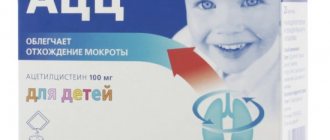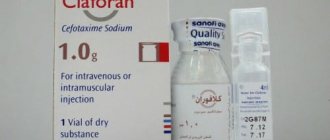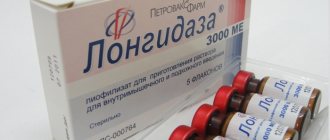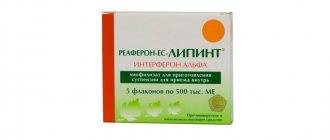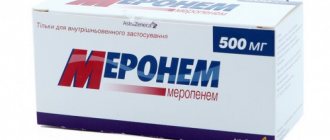Pharmacological properties of the drug Fortum™
Pharmacodynamics . Ceftazidime is a bactericidal cephalosporin antibiotic, the mechanism of action of which is due to disruption of the synthesis of the bacterial cell wall. It has high activity against a wide range of gram-positive and gram-negative bacteria, including strains resistant to gentamicin and other aminoglycoside antibiotics. Very resistant to the action of most β-lactamases produced by both gram-positive and gram-negative microorganisms. in vitro activity and is active within a narrow minimum inhibitory concentration (MIC) range against most infectious agents. In vitro studies have shown that when the drug is used in combination with aminoglycoside antibiotics, an additive effect is noted, and in experiments with some strains, synergistic phenomena were also recorded. In vitro studies have shown that ceftazidime is active against the following microorganisms:
- gram-negative: Pseudomonas aeruginosa, Pseudomonas spp . (including Pseudomonas pseudomallei ), Escherichia coli, Klebsiella spp. (including Klebsiella pneumoniae), Proteus mirabilis, Proteus vulgaris, Morganella morganii (Proteus morganii), Proteus rettgeri, Providencia spp., Enterobacter spp., Citrobacter spp., Serratia spp., Salmonella spp., Shigella spp., Yersinia enterocolitica, Pasteurella multocida, Acinetobacter spp., Neisseria gonorrhoeae, Neisseria meningitidis, Haemophilus influenzae (including ampicillin-resistant strains), Haemophilus parainfluenzae (including ampicillin-resistant strains);
- gram-positive: Staphylococcus aureus (strains sensitive to methicillin) , Staphylococcus epidermidis (strains sensitive to methicillin), Micrococcus spp., Streptococcus pyogenes (β-hemolytic streptococci of group A), Streptococcus group B ( Streptococcus agalactiae ), Streptococcus pneumoniae, Streptococcus m itis , Streptococcus spp. (excluding Streptococcus faecalis );
- anaerobic: Peptococcus spp ., Peptostreptococcus spp., Streptococcus spp., Propionibacterium spp., Clostridium perfringens, Fusobacterium spp., Bacteroides spp. (many strains of Bacteroides fragilis are resistant).
Ceftazidime is inactive in vitro against methicillin-resistant staphylococci, Streptococcus faecalis and many other enterococci, Listeria monocytogenes, Campylobacter spp. and Clostridium difficile . Pharmacokinetics . In patients after intramuscular injection at a dose of 500 mg and 1 g, the average maximum concentration of 18 and 37 mg/l, respectively, is quickly achieved. 5 minutes after an intravenous bolus injection of 500 mg, 1 or 2 g in the blood plasma, an average concentration of 46, 87 or 170 mg/l is achieved, respectively. The therapeutically effective concentration remains in the blood plasma even 8–12 hours after IV and IM administration. Plasma protein binding is about 10%. Concentrations of ceftazidime exceeding the MIC for most common pathogens are achieved in tissues and media such as bone, heart, bile, sputum, intraocular, synovial, pleural and peritoneal fluids. Ceftazidime quickly crosses the placenta and is excreted into breast milk. The drug penetrates poorly through the intact BBB; the concentration of the drug in the central nervous system in the absence of inflammation is insignificant. However, with inflammation of the meninges, the concentration of ceftazidime in the central nervous system is ≥4–20 mg/l, which corresponds to the level of its therapeutic concentration. Ceftazidime is not metabolized in the body. After parenteral administration, a high and stable concentration of ceftazidime in the blood plasma is achieved. The half-life is about 2 hours. The drug is excreted unchanged in its active form by the kidneys by glomerular filtration; about 80–90% of the dose is excreted in the urine within 24 hours. In patients with impaired renal function, the elimination of ceftazidime is reduced, so the dose of the drug should be reduced. Less than 1% of the drug is excreted in the bile, which significantly limits the amount of drug that enters the intestine.
Impact on the body
It is described in detail in the Fortum instructions. This is a third-generation cephalosporin antibiotic that disrupts the synthesis of cell walls of parasitic microorganisms. This is due to its bactericidal effect.
You can highlight a huge list of bacteria against which it is active - the names number in the dozens. However, Fortum injections do not always help. In relation to methicillin-resistant staphylococci, for example, its active substance is powerless. In the same way as for Clostridium difficile, Campylobacter spp., as well as Listeria monocytogenes, Enterococcus spp. and other microorganisms.
That is why it is strictly forbidden to self-medicate. Especially when it comes to antibiotics. First, you need to undergo an examination, take tests, and then begin treatment - and then follow the therapeutic regimen that the doctor has drawn up.
Indications for use of the drug Fortum™
ceftazidime is intended for the treatment of mono- and mixed infections caused by susceptible microorganisms.
- Severe infections: – sepsis, bacteremia, peritonitis, meningitis; – infections in patients with reduced immunity; – in intensive care unit patients, for example with infected burns.
- Respiratory tract infections, including lung infections in patients with cystic fibrosis.
- Infections of ENT organs.
- Urinary tract infections.
- Skin and soft tissue infections.
- Infections of the gastrointestinal tract, biliary tract and abdominal cavity.
- Bone and joint infections.
- Infections associated with hemo- and peritoneal dialysis or continuous ambulatory peritoneal dialysis.
- For prophylactic purposes during surgical interventions on the prostate gland (transurethral resection).
Use of the drug Fortum™
The dose depends on the severity of the disease, sensitivity, location and type of infection, as well as the age and renal function of the patient. It is recommended to conduct a skin tolerance test before using the drug. Adults In most cases, the daily dose is 1-6 g 2-3 times a day by intravenous or intramuscular injection. Urinary tract and less severe infections: 500 mg–1 g every 12 hours. Most infections: 1 g every 8 hours or 2 g every 12 hours. Very severe infections, especially in immunocompromised patients, including those with neutropenia: 2 g every 8 or 12 hours or 3 g every 12 hours. Cystic fibrosis as a complication of Pseudomonas aeruginosa lung infection: from 100 to 150 mg/kg/day in 3 divided doses. Therapy with the drug should be continued for another 2 days after the symptoms of the infection have subsided, but for severe infections, treatment may be longer. Doses up to 9 g/day in adults with normal renal function did not cause any complications. For prophylactic purposes during surgical interventions on the prostate gland, 1 g should be administered during induction of anesthesia, the second dose is administered at the time of removal of the catheter from the urethra. Newborns (0–2 months): 25–60 mg/kg/day as 2 injections. In neonates, the plasma half-life of ceftazidime may be 3–4 times longer than in adults. Children over 2 months of age and up to one year: 30–100 mg/kg/day in 2–3 doses. For children with immunodeficiency, cystic fibrosis or meningitis, it is recommended to administer doses up to 150 mg/kg/day (maximum 6 g/day) in 3 divided doses. Elderly patients. Given the reduced clearance of ceftazidime, in elderly patients with acute infections the daily dose should not exceed 3 g (especially for patients over 80 years of age). The duration of therapy is determined individually. Dosing for renal impairment. Ceftazidime is excreted unchanged in the urine. Therefore, in patients with impaired renal function, the dose should be reduced. The initial dose is 1 g. The determination of the maintenance dose should be based on the glomerular filtration rate. Recommended maintenance doses of ceftazidime for renal failure
Creatinine clearance (ml/min) | Estimated serum creatinine level (μmol/L (mg/dL)) | Recommended single dose of ceftazidime (g) | Dosing frequency (h) |
| 50 | ≤150 (≤1,7) | Usual dose | |
| 50–31 | 150–200 (1,7–2,3) | 1,0 | 12 |
| 30–16 | 200–350 (2,3–4,0) | 1,0 | 24 |
| 15–6 | 350–500 (4,0–5,6) | 0,5 | 24 |
| ≤5 | 500 (5,6) | 0,5 | 48 |
For patients with severe infections, the single dose can be increased by 50% or the frequency of administration increased accordingly. In such patients, it is recommended to monitor the plasma level of ceftazidime, which should not exceed 40 mg/l. In children, creatinine clearance should be adjusted in relation to surface area or body weight. Hemodialysis The half-life of ceftazidime from blood plasma during hemodialysis is 3–5 hours. After each hemodialysis session, a maintenance dose of ceftazidime recommended in the table above should be administered. Peritoneal dialysis Ceftazidime can be used in routine peritoneal dialysis and in long-term ambulatory peritoneal dialysis. In addition to IV use, ceftazidime can be included in the dialysis fluid (usually from 125 to 250 mg per 2 liters of dialysis fluid). For patients with renal failure undergoing long-term arteriovenous hemodialysis or high-flow hemofiltration in intensive care units, the recommended dose is 1 g/day as a single dose or in divided doses. For hemofiltration at a low rate, the same doses should be used as for impaired renal function. For patients undergoing venovenous hemofiltration or venovenous hemodialysis, dosing recommendations are given in the tables. Ceftazidime dosing recommendations for patients undergoing long-term venovenous hemofiltration
Residual kidney function (creatinine clearance, ml/min) | Maintenance dose (mg) depending on ultrafiltration rate (ml/min)* | |||
5 | 16,7 | 33,3 | 50 | |
| 0 | 250 | 250 | 500 | 500 |
| 5 | 250 | 250 | 500 | 500 |
| 10 | 250 | 500 | 500 | 750 |
| 15 | 250 | 500 | 500 | 750 |
| 20 | 500 | 500 | 500 | 750 |
*Maintenance dose should be administered every 12 hours.
Dosing recommendations for ceftazidime in patients undergoing long-term venovenous hemodialysis
Residual kidney function (creatinine clearance, ml/min) | Maintenance dose (mg) depending on ultrafiltration rate (ml/min)* | |||||
1.0 l/h | 2.0 l/h | |||||
Ultrafiltration rate (l/h) | Ultrafiltration rate (l/h) | |||||
0,5 | 1,0 | 2,0 | 0,5 | 1,0 | 2,0 | |
| 0 | 500 | 500 | 500 | 500 | 500 | 750 |
| 5 | 500 | 500 | 750 | 500 | 500 | 750 |
| 10 | 500 | 500 | 750 | 500 | 750 | 1000 |
| 15 | 500 | 750 | 750 | 750 | 750 | 1000 |
| 20 | 750 | 750 | 1000 | 750 | 750 | 1000 |
*Maintenance dose should be administered every 12 hours.
Administration Fortum is administered intravenously or by deep intramuscular injection. IM injection is recommended to be carried out in the upper outer quadrant of the gluteus maximus muscle or the lateral surface of the thigh. Ceftazidime solutions can be administered directly into a vein or into an intravenous infusion system if the patient is undergoing parenteral therapy. Fortum is compatible with the most commonly used solutions for intravenous administration. The dry substance in the bottles is under reduced pressure. As the drug dissolves, carbon dioxide is released and the pressure in the bottle increases. Small bubbles of carbon dioxide in the dissolved drug do not affect its use.
The dose that is administered | Required amount of solvent (ml) | Approximate concentration (mg/ml) | |
| 250 mg | V/m V/v | 1,0 2,5 | 210 90 |
| 500 mg | V/m V/v | 1,5 5 | 260 90 |
| 1 g | IM IV bolus IV infusion | 3 10 50* | 260 90 20 |
| 2 g | IV bolus IV infusion | 10 50* | 170 40 |
*Dissolution should be carried out in 2 stages (see text).
Fortum is compatible with most solutions used for parenteral administration. However, sodium bicarbonate injection should not be used as a solvent (see INTERACTIONS). The color of the solution varies from light yellow to amber depending on the concentration, solvent and storage conditions. If the recommendations are followed, the effect of the drug does not depend on variations in its color. Ceftazidime at a concentration of 1–40 mg/ml is compatible with the following solutions: 0.9% sodium chloride solution; 6M sodium lactate solution; Hartman solution; 5% glucose solution; 0.225% sodium chloride solution in 5% glucose solution; 0.45% sodium chloride solution in 5% glucose solution; 0.9% sodium chloride solution in 5% glucose solution; 0.18% sodium chloride solution in 4% glucose solution; 10% glucose solution; 10% solution of dextran-40 in 0.9% solution of sodium chloride; 10% solution of dextran-40 in 5% solution of glucose; 6% dextran-70 solution in 0.9% sodium chloride solution; 6% dextran-70 solution in 5% glucose solution. Ceftazidime at a concentration of 0.05–0.25 mg/ml is compatible with intraperitoneal dialysis fluid (lactate). Ceftazidime for intramuscular administration can be dissolved in 0.5 or 1% lidocaine solution. The effectiveness of both drugs is maintained when mixing ceftazidime at a dose of 4 mg/ml with the following substances: hydrocortisone (hydrocortisone sodium phosphate) 1 mg/ml in 0.9% sodium chloride solution or 0.5% glucose solution; cefuroxime (cefuroxime sodium) 3 mg/ml in 0.9% sodium chloride solution; cloxacillin (cloxacillin sodium) 4 mg/ml in 0.9% sodium chloride solution; heparin 10 or 50 IU/ml in 0.9% sodium chloride solution; potassium chloride 10 or 40 meq/l in 0.9% sodium chloride solution. The contents of the bottle - 500 mg, dissolved in 1.5 ml of water for injection, can be added to a solution of metronidazole (500 mg in 100 ml), while both drugs retain their activity. Preparation of solutions for intramuscular or intravenous bolus injection Inject the syringe needle through the bottle cap and inject the recommended volume of solvent. Remove the syringe needle and shake the bottle several times to dissolve the dry substance and obtain a clear solution. Turn the bottle over. With the syringe plunger fully inserted, insert the needle into the bottle. Draw the entire solution into the syringe, while the needle should be in the solution at all times. Small bubbles of carbon dioxide can be neglected. Preparation of solutions for intravenous infusion (1 g and 2 g bottles) Inject the syringe needle through the bottle cap and inject 10 ml of solvent. Remove the syringe needle and shake the bottle several times to dissolve the dry substance and obtain a clear solution. Insert an air needle through the cap into the bottle to increase pressure. Without removing the air needle, add another 40 ml of solvent. Remove the air needle, shake the bottle and set up the infusion system as usual. Note. To ensure the sterility of the drug, it is very important not to insert the air needle through the cap of the vial until the drug has dissolved.
Analogs
In some cases, the doctor may prescribe an alternative to his patient. The following drugs are considered to be analogues of Fortum:
- "Ceftazidime."
- "Bestum."
- "Kefadim."
- "Tasicephus".
- "Fortazim."
- "Tizim."
- "Ceftidine".
- "Vicef."
- "Cefzid."
- "Orzid."
These are analogues of antibiotics based on the active substance. And there are also alternative drugs that are similar in effect to Fortum. The most popular medications are:
- "Zavicefta".
- "Ceftriaxone".
- "Cefosin".
- "Axoseph."
- "Cefuroxime Kabi".
- "Cephurus".
- "Axoseph."
- "Zinnat".
- "Biseptol".
- "Tsiprolet".
- "Tsifran".
- "Ciprobey".
- "Ecocifol".
- "Ciprinol".
And this is not all the drugs that doctors sometimes use to replace Fortum. However, remember: self-medication does not lead to anything good - the antibiotic should be prescribed by the attending doctor, and no one else.
Side effects of the drug Fortum™
Side effects were classified by organs and systems and by the frequency of their occurrence: very often (1/10); often (1/100–1/10); uncommon (1/1000–1/100); rare (1/10,000–1/1000); very rare (1/10,000). Infections and infestations Uncommon : candidiasis (including vaginitis and aphthous stomatitis). Blood and lymphatic systems Often - eosinophilia and thrombocytosis; uncommon - leukopenia, neutropenia and thrombocytopenia; very rarely - lymphocytosis, hemolytic anemia and agranulocytosis. Immune system Very rarely - anaphylaxis (including bronchospasm and/or hypotension). CNS Uncommon : dizziness, headache; very rarely - paresthesia. Cases of neurological complications such as tremor, myoclonus, convulsions, encephalopathy and coma have been reported in patients with renal failure for whom the dose of ceftazidime was not appropriately reduced. Vascular disorders Often - phlebitis or thrombophlebitis at the site of drug administration. Gastrointestinal disorders Often - diarrhea; uncommon - nausea, vomiting, abdominal pain, colitis; very rarely - taste disturbance. As with other cephalosporins, colitis may manifest as pseudomembranous colitis associated with Clostridium difficile. From the urinary system Very rarely - interstitial nephritis, acute renal failure. Reactions from the hepatobiliary system Often - a transient increase in the level of liver enzymes (ALAT, AST, LDH, gamma-glutamine transferase, alkaline phosphatase); very rarely - jaundice. Skin and subcutaneous tissue disorders Common : maculopapular rash or urticaria; infrequently - itching; very rarely - angioedema, erythema multiforme, Stevens-Johnson syndrome and toxic epidermal necrolysis. General reactions and disorders at the injection site Often - pain and/or inflammation at the site of intravenous injection; infrequently - fever. Laboratory indicators Often - positive Coombs test; infrequently - as with the use of some other cephalosporins, a transient increase in the level of urea, urea nitrogen and/or creatinine in the blood plasma was sometimes noted. A positive Coombs test is observed in approximately 5% of patients, which may affect the accuracy of the blood typing result.
Overdose
It can occur due to improper use of the antibiotic Fortum. The main symptom of overdose is neurological disorders, including seizures, encephalopathy and coma.
Treatment consists of supportive and symptomatic therapy. Doctors often resort to peritoneal dialysis and hemodialysis - these methods help normalize the concentration of ceftazidime.
Special instructions for the use of Fortum™
Before starting treatment, the patient should exclude a history of hypersensitivity reactions to the administration of ceftazidime or other cephalosporin antibiotics or penicillins. Ceftazidime should be prescribed with extreme caution to patients who have a history of an allergic reaction to penicillins or other β-lactam antibiotics. If an allergic reaction to ceftazidime occurs, discontinue use of the drug immediately. If severe hypersensitivity reactions occur, the use of epinephrine, hydrocortisone, antihistamines and other emergency medications may be necessary. Concomitant use of high doses of cephalosporins and nephrotoxic drugs (aminoglycosides or potent diuretics (furosemide)) may adversely affect renal function. Experience with the clinical use of ceftazidime has shown that this phenomenon is unlikely if the recommended doses are observed. There is no evidence of an adverse effect of ceftazidime, used in usual therapeutic doses, on renal function. Ceftazidime is excreted by the kidneys, so the dose should be reduced according to the degree of renal impairment. Cases of neurological complications have been reported if the dose was not appropriately reduced. As with the use of other broad-spectrum antibiotics, prolonged treatment with Fortum may lead to an excessive increase in the number of insensitive microorganisms (for example, Candida, Enterococci ); in this case, it may be necessary to discontinue treatment or apply appropriate measures. It is very important to constantly monitor the patient's condition. As with other cephalosporins and broad-spectrum antibiotics, some previously susceptible strains of Enterobacter spp . and Serratia spp. may become resistant during treatment with ceftazidime. To monitor the development of microflora resistance during treatment, microflora should be periodically tested for sensitivity to antibiotics. During pregnancy and breastfeeding. Experimental evidence of embryotoxic and teratogenic effects of ceftazidime has not been identified, but, like other drugs, it should be prescribed with caution to women in the first trimester of pregnancy and infants. Ceftazidime passes into breast milk in small amounts and should therefore be administered with caution during breastfeeding. Children . It is used in children from the first days of life. The effect on the ability to drive vehicles and other machinery has not been described .
Contraindications
It is strictly forbidden to prescribe this drug to a patient if he experiences the reactions listed below:
- Hypersensitivity to any components of the antibiotic (including the main active ingredient).
- Allergy to other cephalosporins and penicillins.
The drug may be prescribed with caution during pregnancy, renal failure, the lactation period, as well as gastrointestinal pathologies. Newborns and people taking loop diuretics and aminoglycosides are also allowed to take the antibiotic under medical supervision.
Drug interactions Fortum™
Combination therapy of high-dose cephalosporins with nephrotoxic drugs may adversely affect renal function. Chloramphenicol in vitro to ceftazidime and other cephalosporins. The clinical significance of this phenomenon is unknown, however, if concomitant use of Fortum with chloramphenicol is proposed, the possibility of antagonism should be considered. Like other antibiotics, Fortum can affect the intestinal microflora, which leads to a decrease in estrogen reabsorption and a decrease in the effectiveness of combined oral contraceptives. Ceftazidime does not affect the results of determining glucose in urine by enzymatic methods and has a slight effect on the results of the study when using methods based on copper reduction (Benedict, Felling, Clinitest). Ceftazidime does not affect the alkaline picrate method for determining creatinine. Incompatibility Fortum is less stable in sodium bicarbonate solution for injection than in other solutions for intravenous administration, therefore it is not recommended for use as a solvent. Ceftazidime and aminoglycosides should not be mixed in the same infusion set or syringe. When adding vancomycin solution to ceftazidime, sediment may form, so it is recommended to flush infusion systems and IV catheters between use of these drugs.
Reviews
The discussion of the drug should be completed with this important topic. If you believe the few reviews left about the antibiotic Fortum, then this is a really good drug.
Some argue that it is capable of improving the patient’s condition in a matter of days, even with advanced pneumonia, which not all drugs can help cope with.
Parents of young children also have a good opinion about this remedy. Of course, “Fortum” does not cure children, like adults, in the blink of an eye, but gradually severe symptoms soften - the temperature goes away, normal sleep returns, wheezing disappears, and the condition improves.
If the patient is diagnosed with an infection in an unadvanced stage, then the antibiotic will completely normalize the state of health in one day, but nevertheless the course cannot be interrupted.
Doctors also consider the drug a good remedy. It is noted that this is a high-quality antibiotic, often used in hospital practice, since it has long proven its activity against many pathogens (even Pseudomonas aeruginosa). And in some cases, “Fortum” is completely irreplaceable, especially if the patient “caught” a hospital infection.

